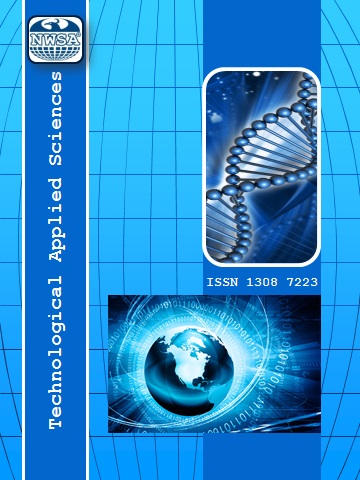References
[1] Demir, Z. and Adiyaman, O., (2019). Investigation of influence of approach angle and chip slenderness ratio on vibration, chip formation and surface quality in turning of AISI 1050 steel. Journal of the Brazilian Society of Mechanical Sciences and Engineering, 41(10):467. Doi: 10.1007/s40430-019-1977-3.
[2] Kronenberg, M., (1996). Machining science and application theory and practice for operation anddevelopment of machining processes. Arrowsmit Ltd. UK, 1-11.
[3] Thamizhmanii, S. and Sulaiman, H., (2012). Machinability study using chip thickness ratio on difficult to cut metals by CBN cutting tool. Key Engineering Materials, 504:1317-1322. Doi:10.4028/www.scientific.net/KEÖ.504-506.1317.
[4] Astakhov, V.P. and Shvets, S., (2004). The assessment of plastic deformation in metal cutting. Journal of Materials Processing Technology, 146:193-202.
[5] Varga, G., (2012). Examination of shear angle in metal cutting. Production Processes and Systems, 1:71-78.
[6] Silva, L.R., Abra, A.M., Faria. P., and Davim, J.P., (2012). Machinability study of steels in precision orthogonal cutting. Materials Research, 15(4):589-595. Doi:10.1590/S1516-14392012005000071.
[7] Atlati, S., Haddag, B., Nouari, M., and Zenasni, M., (2011). Analysis of a new segmentation intensity ratio SIR to characterize the chip segmentation process in machining ductile metals. International Journal of Machine Tools & Manufacture, 51:687-700. Doi: 10.1016/j.ijmachtools.2011.05.007.
[8] Ahearne, E. and Baron, S., (2017). Fundamental mechanisms in orthogonal cutting of medical grade cobalt chromium alloy (ASTM F75). CIRP Journal of Manufacturing Science and Technology, 19:1-6. Doi: 10.1016/j.cirpj.2017.02.001.
[9] Ducobi, F., Lorphevre, E.R., and Filippi, E., (2016). Materials constitutive model and chip separation criterion influence on the modeling of Ti6Al4V machining with experimental validation in strictly orthogonal cutting condition. International Journal of Mechanical Sciences, 107:136-149. Doi: 10.1016/j.ijmecsci.2016.01.008.
[10] Cui, X. and Guo, J., (2017). Effects of cutting parameters on tool temperatures in intermittent turning with the formation of serrated chip considered. Applied Thermal Engineering, 110:1220-1229. Doi: 10.1016/j.applthermaleng.2016.09.048.
[11] Liu, H.Z., Wang, S.J., and Zong, W.J., (2019). Tool rake angle selection in micro-machining of 45 vol.%SiCp/2004Al based on its brittle-plastic properties. Journal of Manufacturing Processes, 37:556-562. Doi: 10.1016/j.jmapro. 2018.12.030.
[12] Ye, G.G., Jiang, M.Q., Xue, S.F., Ma, W., and Dai, L.H., (2018). On the instability of chip flow in high- speed machining. Mechanics of Materials, 116:104-119. Doi: 10.1016/j.mechmat. 2017.02.006.
[13] Palacios, J.A., Olvera, D., Urbikain, G., Zuniga, A.E., Romero, O.M., Lacalle, L.N.L., Rodriguez, C., and Alfaro, H.M., (2018). Combination of simulated annealing and pseudo spectral methods for the optimum removal rate in turning operations of nickel-based alloys. Advances in Engineering Software, 115:391-397. Doi: 10.1016/j.advangsoft.2017.10.008.
[14] Duan, C., Dou, T., and Wang, M., (2009). Experimental Research of chip formation mechanism during high speed machining of hardened steel. International Journal of Advanced Engineering Applications (IJAEA), 2(3):17-21.
[15] Dahlman, P., Gunnberg, F., and Jacobson, M., (2004). The influence of rake angle, cutting feed and cutting depth on residual stresses in hard turning. Journal of Materials Technology, 147:181-184. Doi: 10.1016/j.matprotec.2013.12.014.
[16] Zhu, Z., Guo, K., Sun, J., Li, J., Liu, Y., Chen, L., and Zheng, Y., (2018). Evolution of 3D chip morphology and phase transformation in dry drilling Ti6Al4V alloys. Journal of Manufacturing Processes, 34:531-539. Doi: 10.1016/j.jmapro.2018.07.001.
[17] Outeiro, J.C., Costes, J.P., and Kornmeier, J.R., (2013). Cyclic variation of residual stress induced by tool vibration in machining operations. Procedia CIRP, 8:493-497. Doi: 10.1016/j.procir.2013.06.139.
[18] Adıyaman, O., (2021). Regression Modeling of the effect of chip slenderness ratio and cutting parameters on vibration. Gazi University Journal of Science Part C: Design and Technology, 9(4):661-678. Doi: 10.29109/gujsc.933055.
[19] Liu, R., Eaton, E., Yu, M., and Kuang, J., (2017). An investigation of side flow during chip formation in orthogonal cutting. Procedia Manufacturing, 10:568-577. Doi: 10.1016/j.promfg.2017.07.053.
[20] Demir, Z. and Adıyaman, O. (2019). Investigation of the effect of Chip Slenderness Ratio and Cutting Tool Approach Angle on Vibration Amplitudes and Chip Morphology. Celal Bayar University Journal of Science, 15(4):423-431. Doi: 10.18466/cbayarfbe.629157.
[21] Martín Umbert, S., (2018). Cutting forces in turning operations. Bachelor's thesis, Universitat Politècnica de Catalunya.
[22] Cutting mechanics, http://www.me.unlv.edu/Undergraduate /coursenotes/wang/meg426/web/wk3/CLASS3.htm. Access Date: 17.12.2023.
[23] Mechanics of Cutting. chrome-extension:// efaidnbmnnnibpcajpcglclefindmkaj/https://home.iitk.ac.in/~vkjain/L6-TA-202%20MECHANICS%20OF%20CUTTING.pdf. Access Date: 17.12.2023
 +90(533) 652 66 86
+90(533) 652 66 86 nwsa.akademi@hotmail.com
nwsa.akademi@hotmail.com Fırat Akademi Samsun-Türkiye
Fırat Akademi Samsun-Türkiye
